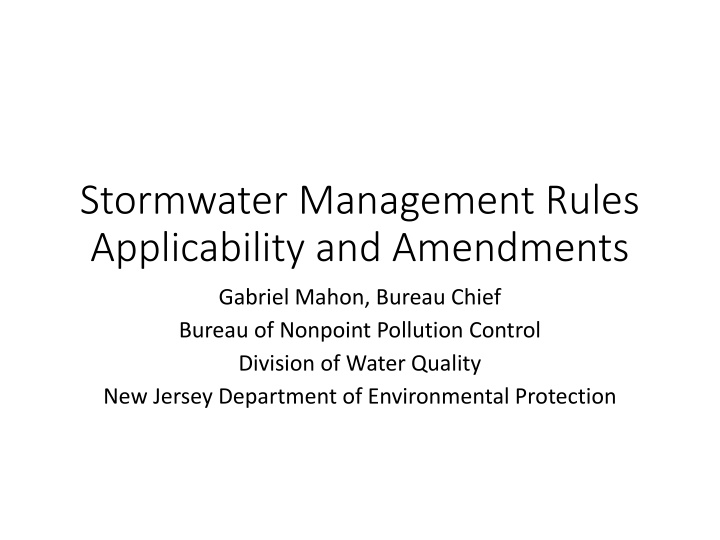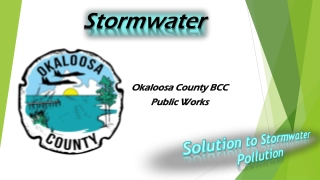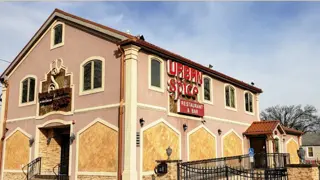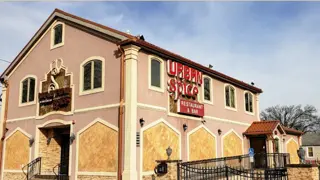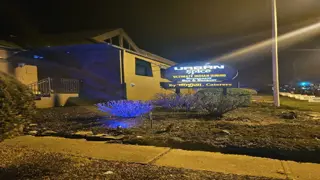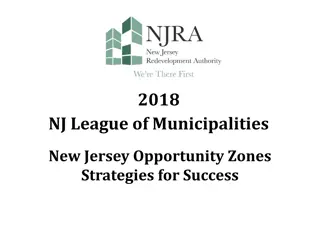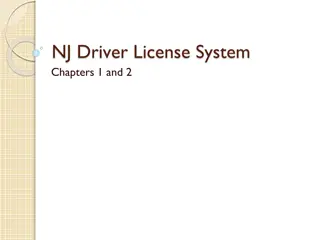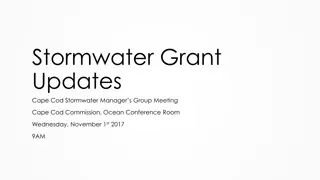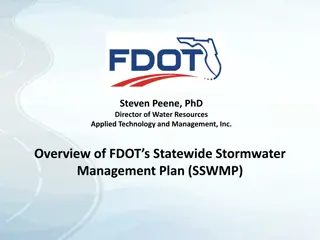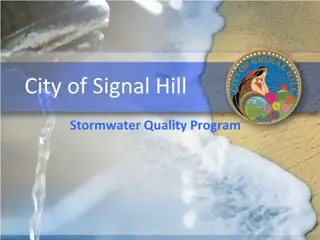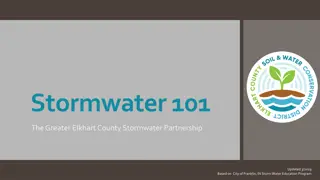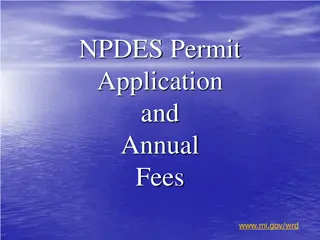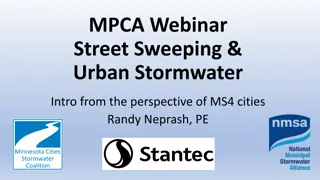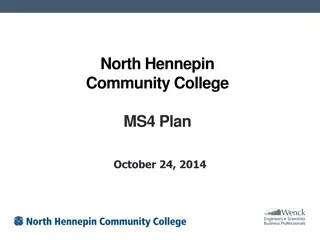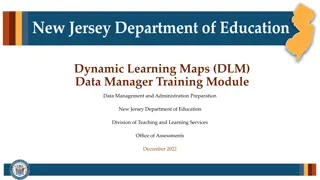Post-Construction Stormwater Management in New Jersey
New Jersey's stormwater management rules at N.J.A.C. 7:8 require compliance through permits issued by the Division of Land Use Regulation or MS4 permits issued by the Bureau of Nonpoint Pollution Control, depending on the type of project. Major developments must comply if they disturb one acre or more of land. Proposed amendments aim for consistency, predictability, and water quality improvements in stormwater management. The existing rule layout includes design and performance standards for various stormwater management measures.
Download Presentation

Please find below an Image/Link to download the presentation.
The content on the website is provided AS IS for your information and personal use only. It may not be sold, licensed, or shared on other websites without obtaining consent from the author.If you encounter any issues during the download, it is possible that the publisher has removed the file from their server.
You are allowed to download the files provided on this website for personal or commercial use, subject to the condition that they are used lawfully. All files are the property of their respective owners.
The content on the website is provided AS IS for your information and personal use only. It may not be sold, licensed, or shared on other websites without obtaining consent from the author.
E N D
Presentation Transcript
Stormwater Management Rules Applicability and Amendments Gabriel Mahon, Bureau Chief Bureau of Nonpoint Pollution Control Division of Water Quality New Jersey Department of Environmental Protection
How is post-construction stormwater managed in NJ? Stormwater Management rules at N.J.A.C. 7:8 Compliance required through permits issued by the Division of Land Use Regulation Direct Implementation by NJDEP Compliance required through MS4 Permits issued by the Bureau of Nonpoint Pollution Control in the Division of Water Quality Implementation by municipality RSIS for residential projects Stormwater Control Ordinance for non-residential projects
What projects must comply? Major Development Under existing rules: If reviewed by NJDEP any development or developments that ultimately disturb one acre or more of land or create acre or more increase of impervious surface If reviewed by the municipality Through RSIS ultimate disturbance of one acre or more Through Stormwater Ordinance as defined in ordinance (but must at least cover projects that where the ultimate disturbance is one acre or more)
Proposed Amendments to Stormwater Management rules Dec. 3, 2018: NJDEP proposed amendments to the Stormwater Management rules. Feb. 1, 2019: 60-day public comment period closed Dec. 3, 2019: NJDEP filed adoption package to OAL Adoption includes a 1 year delayed operative date Current rules are in effect during this year Same timeframe municipalities have to update ordinances in accordance with MS4 permits
Goals of the Amendments Goals of the Amendments 1. Consistency 2. Predictability 3. Water Quality Improvements
Existing Rule Layout Existing Rule Layout SUBCHAPTER 5. DESIGN AND PERFORMANCE STANDARDS FOR STORMWATER MANAGEMENT MEASURES 7:8-5.1 Scope 7:8-5.2 Stormwater management measures for major development 7:8-5.3 Nonstructural stormwater management strategies 7:8-5.4 Erosion control, groundwater recharge and runoff quantity standards 7:8-5.5 Stormwater runoff quality standards 7:8-5.6 Calculation of stormwater runoff and groundwater recharge 7:8-5.7 Standards for structural stormwater management measures 7:8-5.8 Maintenance requirements 7:8-5.9 Sources for technical guidance
Rule Layout Re Rule Layout Re- -arrangement arrangement SUBCHAPTER 5. DESIGN AND PERFORMANCE STANDARDS FOR STORMWATER MANAGEMENT MEASURES 7:8-5.1 Scope 7:8-5.2 Stormwater management measures for major development 7:8-5.3 Nonstructural stormwater management strategies GI 7:8-5.4 Erosion control, groundwater recharge and runoff quantity standards 7:8-5.5 Stormwater runoff quality standards 7:8-5.6 Calculation of stormwater runoff and groundwater recharge 7:8-5.7 Standards for structural stormwater management measures 7:8-5.8 Maintenance requirements 7:8-5.9 Sources for technical guidance
Amended Rule Layout Amended Rule Layout SUBCHAPTER 5. DESIGN AND PERFORMANCE STANDARDS FOR STORMWATER MANAGEMENT MEASURES 7:8-5.1 Scope 7:8-5.2 Stormwater management measures for major development 7:8-5.3 Green infrastructure 7:8-5.4 Groundwater recharge standards 7:8-5.5 Stormwater runoff quality standards 7:8-5.6 Stormwater runoff quantity standards 7:8-5.7 Calculation of stormwater runoff and groundwater recharge 7:8-5.8 Maintenance requirements 7:8-5.9 Sources for technical guidance
Green Infrastructure Definition Green Infrastructure Definition A stormwater management measure that manages stormwater close to its source by: 1. Treating stormwater runoff through infiltration into subsoil; 2. Treating stormwater runoff through filtration by vegetation or soil, or 3. Storing stormwater runoff for reuse.
Green Infrastructure Standard Green Infrastructure Standard GI BMPs must be used to satisfy recharge, quantity, and quality 3 Tables identifying the performance of each BMP in meeting the 3 standards Water Quality & Recharge BMPs in Table 1 Quantity BMPs in Table 1 or Table 2 If received a variance BMPs in Table 1, Table 2, or Table 3 Maintain existing ability to propose an alternative stormwater design. Alternative design must meet GI definition and must meet drainage area limitation if similar to BMP with limit.
Table 1 Best Management Practice Quality Quantity Recharge Minimum separation from TSS removal rate seasonal high water table (percent) (feet) Cisterns 0 Yes No - Dry Wells 0 No Yes 2 Grass Swales 50 or less No No 2 Green Roofs 0 Yes No - Manufactured Treatment Device 50 or 80 No No Dependent upon the (MTDs) device Pervious Paving Systems 80 Yes Yes 2 No 1 Small-scale Bioretention 80 or 90 Yes Yes 2 Systems No 1 Small-scale Infiltration Basins 80 Yes Yes 2 Small-scale Sand Filters 80 Yes Yes 2 Vegetative Filter Strips 60-80 No No - Table 1 BMPs shall be used for recharge, quantity, and quality Drainage area limitation applies to: dry wells, MTDs, pervious paving system, and small-scale bioretention, infiltration, and sand filters. Table 1 only includes MTDs that meet the definition of GI
Table 2 Best Management Practice Quality Quantity Recharge Minimum separation TSS removal rate from seasonal high water (percent) table (feet) Bioretention Systems 80 or 90 Yes Yes 2 No 1 Infiltration Basins 80 Yes Yes 2 Sand Filter 80 Yes Yes 2 Standard Constructed Wetlands 90 Yes No N/A Wet Ponds 50-90 Yes No N/A Wet ponds used under Table 2 must designed to have native vegetation and a reuse component Table 2 BMPs may only be used for quantity
Table 3 Best Management Practice Quality Quantity Recharge Minimum separation from TSS removal rate seasonal high water table (percent) (feet) Blue Roofs 0 Yes No N/A Extended Detention Basins 40-60 Yes No 1 Manufactured Treatment Device 50 or 80 No No Dependent upon the device Sand Filters 80 Yes No 1 Subsurface Gravel Wetlands 90 No No 1 Wet ponds 50-90 Yes No N/A Table 3 BMPs may only be used if a variance is granted
Water Quality Water Quality Motor Vehicle Surface Motor Vehicle Surface The water quality standard will apply to motor vehicle surface instead of impervious surface Rule text will not require roofs or sidewalks to be treated consistent with current implementation Will require pervious motor vehicle surfaces to be treated consistent with scientific studies Include in definition of major development
Clarification to Applicability Clarification to Applicability Add definition of regulated motor vehicle surface Add definition of regulated impervious surface Change definition of major development to be 1 acre of disturbance, or acre of regulated impervious surface, or acre of regulated motor vehicle surface Definitions of regulated motor vehicle surface and regulated impervious surface will include FAQ 10.2 (newly collected impervious surface and changes to existing drainage systems count as new )
Clarification to Applicability Clarification to Applicability Require quantity, quality, and groundwater recharge to be met in each drainage area on-site (unless they converge before leaving the property) Move mounding analysis requirement from recharge standard to apply to all infiltration BMPs
CSO Related Changes CSO Related Changes Clarify that water quality treatment is required for discharges into combined sewer systems Clarify that water quantity control is required in tidal areas except discharges directly into lower reach of major tidal waterbodies Create the option for a community basin, which will allow several properties in a CSS community to use a single large basin for quantity control Other standards must still be met on-site (including GI)
